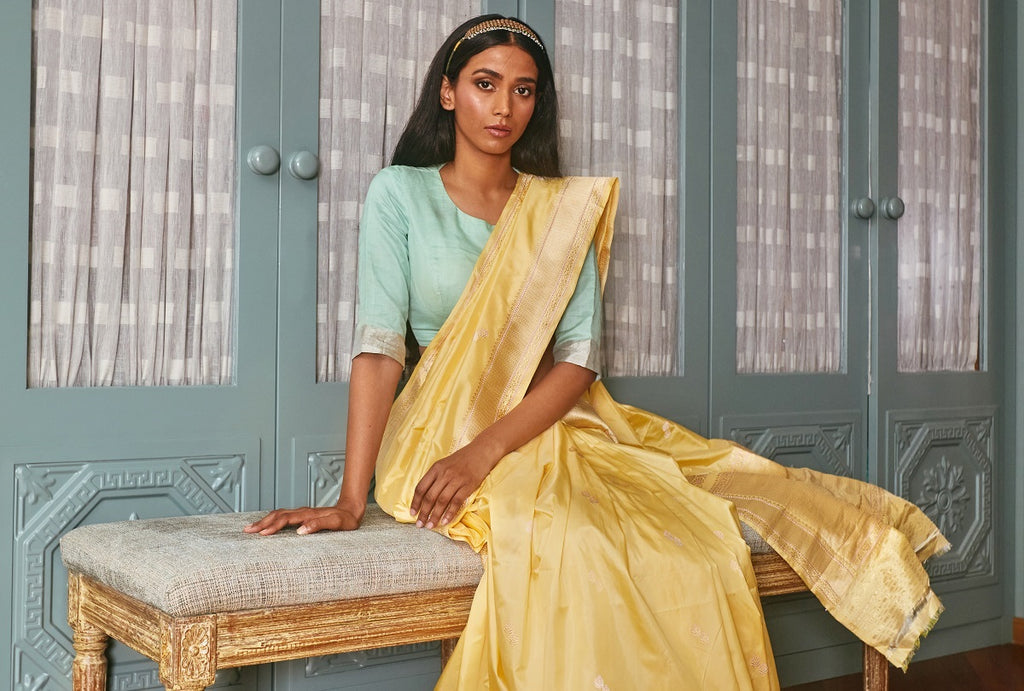The Heritage of Handwoven Banarasi Sarees
Posted by GO NATIVE

Banarasi sarees are a timeless piece of Indian heritage, known for their intricate designs, luxurious fabric, and unparalleled beauty. These sarees have been woven in the city of Varanasi (also known as Banaras) for over a thousand years and are considered to be some of the finest sarees in India. Handwoven Banarasi sarees are not just a piece of clothing, they are a symbol of the rich cultural heritage of India and the skills of the weavers who create them.

The Process:
Weaving a Banarasi saree is a complex and labor-intensive process that requires a great deal of skill, patience, and attention to detail. It can take anywhere from 15 to 30 days to complete a single saree, depending on its design and intricacy.
The first step in the weaving process is to spin the raw silk into fine threads. This is done by hand, using a spinning wheel called a charkha. Once the silk has been spun, it is then dyed using natural dyes to create the vibrant colors that are associated with Banarasi sarees.
Next, the silk threads are woven on a loom, which is a complex machine that uses a series of threads to create the fabric. The weaver must carefully arrange the threads to create the desired design. This is done using a process called jacquard weaving, which allows the weaver to create intricate patterns and designs by controlling the movement of individual threads.

The weaver then adds the zari, which is a thin thread made of pure gold or silver, to the fabric. The zari is added to the fabric in a carefully controlled pattern, creating the shimmering effect that is so characteristic of Banarasi sarees.
Once the fabric has been woven, it is then ready to be transformed into a saree. This involves a series of steps, including washing, ironing, and hemming the edges of the fabric to create the finished product.
The Design
Banarasi sarees are known for their intricate designs, which range from simple, geometric patterns to elaborate floral designs. The most common design elements in Banarasi sarees include paisleys, flowers, leaves, and vines. The designs are created by the weaver, who uses the jacquard weaving process to control the movement of individual threads and create the desired pattern.
The colors used in Banarasi sarees are also an important part of the design process. Traditionally, Banarasi sarees were made using natural dyes, which created rich, vibrant colors that were resistant to fading. Today, Banarasi sarees are also made using synthetic dyes, which are more affordable and easier to use, but the traditional methods of using natural dyes are still used in some parts of Varanasi.
The Fabric of Banarasi Sarees

Banarasi sarees are made using fine silk, which is known for its luxurious feel and shimmering appearance. The silk used in Banarasi sarees is called "Banarasi silk", which is a special type of silk that is only produced in the city of Varanasi. The silk is spun into fine threads and then woven on a loom to create the fabric for the saree.
The unique properties of Banarasi silk make it an ideal material for handwoven sarees. The silk is soft, lightweight, and has a lustrous sheen that adds to the beauty of the saree. It is also durable, making it a great investment!

At GoNative, we are proud to offer a beautiful collection of handloom Banarasi sarees. These sarees are woven by skilled artisans using traditional techniques passed down from generation to generation. The intricate hand-embroidery, including the famous Banarasi zari and silk, is a true testament to the artistry of the weavers. Our handloom Banarasi sarees are the perfect addition to any wardrobe!
